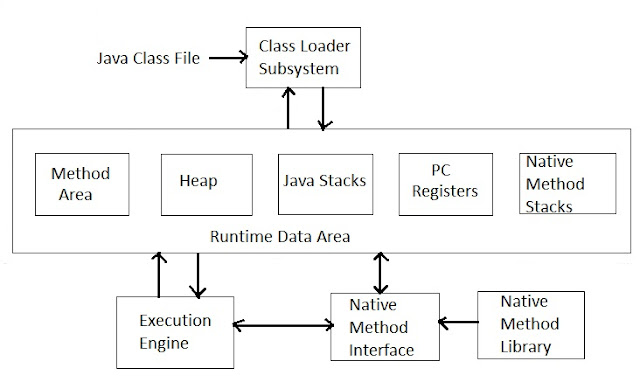In this post, we will learn more about JVM Architecture in Java and components of JVM in detail.
JVM is a Java Virtual Machine and was developed with the concept of Write Once Runs Anywhere, which runs on a Virtual Machine. The compiler compiles the Java file into a Java .class file, and then that .class file is input to the JVM, which loads and executes the class file.
As shown in the above diagram, a JVM is divided into three main subsystems,
Java's dynamic class loading functionality is handled by the class loader subsystem. It loads, links and initializes the class when it refer to the class for the first time at run time, not at compile time. It performs three major functionality such as Loading, Linking and Intialization.
This is the final phase of the class loading , here all static variables will be assigned with the original values and the static block will be executed.
The Runtime Data Area is divided into 5 major components as below,
1) Method Area
For every thread, a separate run time stack will be created. For every method call , one entry will be made in the stack memory which is called as Stack Frame. All Local variables will be created in the stack memory. The Stack Area is a thread safe since it's not a shared resource. The Stack Area is divided into three sub entities : Local Variable Array, Operand Stack & Frame data.
4) PC Registers
Native method stack holds native method information. For every thread, a separate native method stack will be created.
The byte code which is assigned to the Runtime Data Area will be executed by the Execution Engine. The Execution Engine reads the byte code and executes the code step by step as follows,
What is JVM ?
JVM is a Java Virtual Machine and was developed with the concept of Write Once Runs Anywhere, which runs on a Virtual Machine. The compiler compiles the Java file into a Java .class file, and then that .class file is input to the JVM, which loads and executes the class file.
JVM Architecure Design:
How does the JVM works?
As shown in the above diagram, a JVM is divided into three main subsystems,
1) Class Loader Subsystem
2) Runtime Data Area
3) Exceution Engine
1) Class Loader subsystem
Java's dynamic class loading functionality is handled by the class loader subsystem. It loads, links and initializes the class when it refer to the class for the first time at run time, not at compile time. It performs three major functionality such as Loading, Linking and Intialization.
1.1) Loading
Classes will be loaded by this component. There are three class loaders which can help to load the classes at run time as BootStrap ClassLoader, Extension ClassLoader and Application ClassLoader.
- BootStrap ClassLoader
Responsible for loading the classes from the bootstrap classpath , nothing but rt.jar. Highest priority will be given to this loader
- Extension ClassLoader
Responsible for loading classes which are inside ext folder (jre/lib).
- Application ClassLoader
Responsible for loading Application Level Classpath, path mentioned environment variable etc.
1.2) Linking
- Verify - Byte code verifier will verify if the generated byte code is proper or not. If not a proper then will get Verification error.
- Prepare - For all static variables memory will be allocated and assigned with default values.
- Resolve - For all symbolic memory references are replace with original references from method area.
1.3) Intialization
This is the final phase of the class loading , here all static variables will be assigned with the original values and the static block will be executed.
2) Runtime Data Area
The Runtime Data Area is divided into 5 major components as below,
1) Method Area
All the class level data will be stored here, including the static variables. There is only one method area per JVM and it's shared resource.
2) Heap area
2) Heap area
All the objects and their corresponding instance variables and Arrays will be stored here. There is only one Heap Area per JVM. Since the Method and Heap area share memory for multiple threads, data stored is not thread safe.
3) Stack Area
3) Stack Area
For every thread, a separate run time stack will be created. For every method call , one entry will be made in the stack memory which is called as Stack Frame. All Local variables will be created in the stack memory. The Stack Area is a thread safe since it's not a shared resource. The Stack Area is divided into three sub entities : Local Variable Array, Operand Stack & Frame data.
4) PC Registers
Each thread will have separate PC Registers, to hold the address of current executing instruction once the instruction is executed the PC Register will be updated with the next instruction
5) Native Method Stacks
5) Native Method Stacks
Native method stack holds native method information. For every thread, a separate native method stack will be created.
3) Execution Engine
The byte code which is assigned to the Runtime Data Area will be executed by the Execution Engine. The Execution Engine reads the byte code and executes the code step by step as follows,
- Interpreter
- JIT Compiler
- Garbage Collector
Java Native Interface(JNI) : -
JNI will be interacting with the Native Method Libraries and provides the Native Libraries for the Execution Engine.
Native Method Libraries: -
It is a collection of the Native Libraries which is required for the Execution Engine.
Related Posts:--

nice blog. Thank you for sharing java tutorial.keep sharing tutorials.........
ReplyDeletethank you for sharing Driving School Ringwood
ReplyDelete